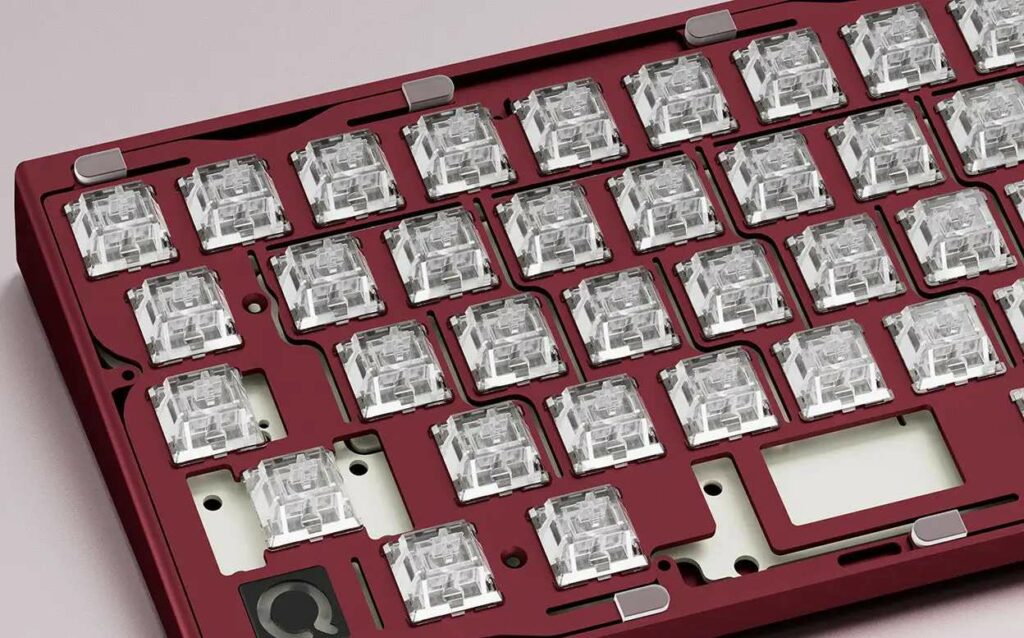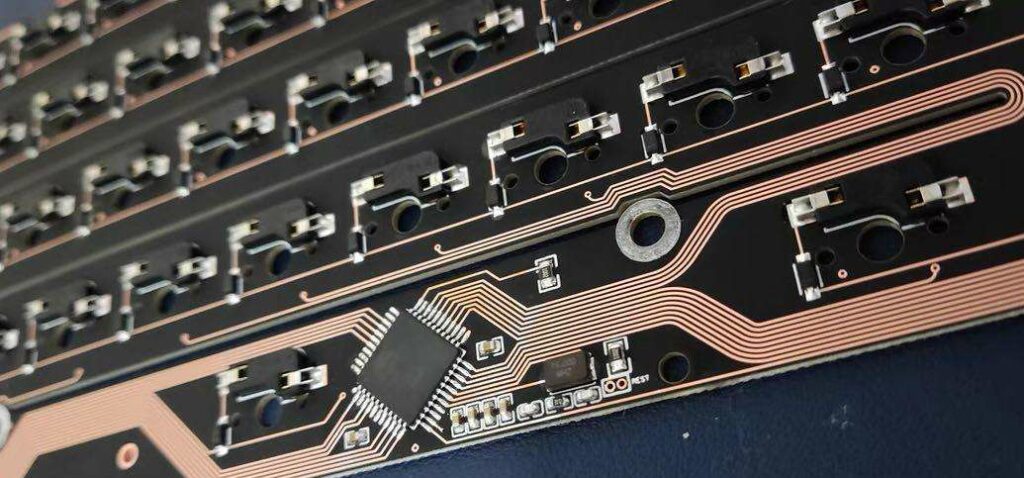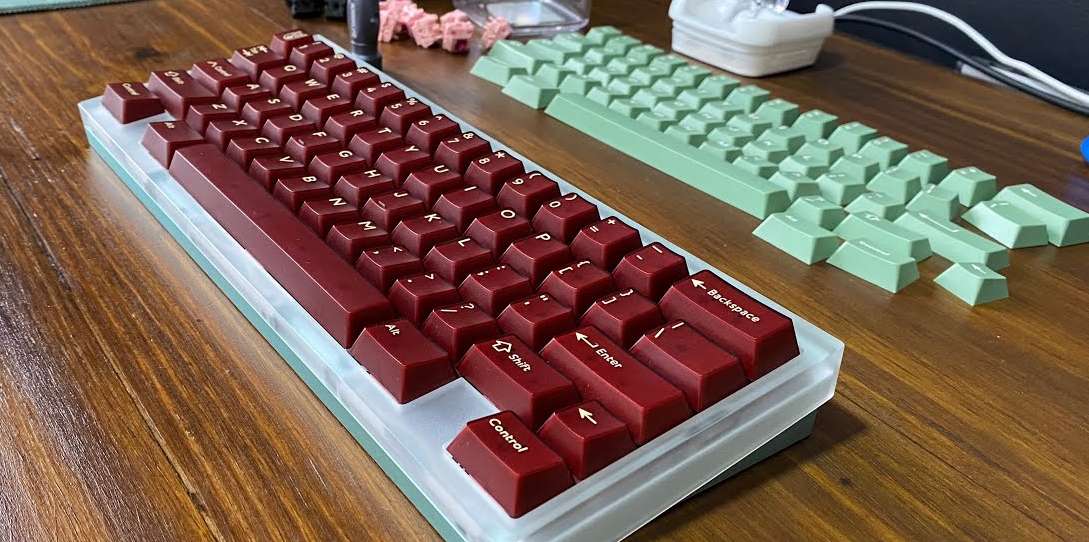A qk60 PCB (printed circuit board) is a circuit board designed for 60% form factor mechanical keyboards, specifically ones following the qk60 layout. Qk60 keyboards are compact 60% boards with arrow keys, making them a popular choice for productivity and coding.
Some key things to know about qk60 PCBs:
Main Features of qk60 PCB
- Compatible with 60% keyboard case that support qk60 layout
- Supports QMK/VIA for full programmability
- USB-C connector for connecting to computer
- Designed for hotswap switch sockets or soldered switches
- RGB underglow and per-key LED support
- Powerful 32-bit ARM microcontroller
- Support for Bluetooth and wireless connectivity
Layout and Size
- 60% form factor plus dedicated arrow keys
- 61 total keys in qk60 ANSI layout
- Compact overall footprint without compromising on arrow keys
- Fits in aftermarket 60% cases designed for qk60
Customization and Modifications
- QMK/VIA allows complete customization of layouts and layers
- Many PCBs support switch and layout modifications
- RGB lighting is customizable for unique lighting effects
- PCB foam and plate material changes alter sound and feel
As you can see, qk60 offers a compact, functional and customizable 60% keyboard experience perfect for enthusiasts and power users. Now let’s dive deeper into qk60 PCB specifics.
Detailed qk60 PCB Features and Specifications

Microcontrollers
The microcontroller (MCU) is the brain of a keyboard PCB, responsible for registering key presses, lighting control, connectivity and running any custom firmware. Here are some common MCUs used on qk60 boards:
| Microcontroller | Description |
|---|---|
| Atmel ATmega32U4 | Common 8-bit MCU, limited memory |
| Elite-C variants | ATmega32U4 with USB-C, popular upgrade |
| STM32F303 | 32-bit ARM Cortex-M4, very capable |
| GD32VF103 | RISC-V based, interesting new option |
The most featured qk60 boards will use a 32-bit STM32 ARM chip or GD32 RISC-V MCU for maximum performance headroom. This allows complex lighting control, wireless connectivity stacks, fast USB polling rates, and firmware flexibility for advanced mods.
Switch Sockets
Qk60 PCBs support either soldered switches or hotswap switch sockets. Here is an overview:
| Type | Description | Pros | Cons |
|---|---|---|---|
| Soldered | Switches must be soldered to PCB | Consistent feel and sound, simple design | Cannot swap switches easily |
| Hotswap | Removable switch housings with pins | Easily swap switches to customize | More complex PCB, looser switch feel |
Hotswap is generally preferred as it offers flexibility and customization. Common hotswap sockets include:
- Kailh sockets – gold plated pins, various styles
- Mill-max sockets – high quality, reusable
For the simplest keyboard build, a PCB with pre-installed Kailh or similar hotswap sockets allows dropping in any compatible mechanical switch with no soldering needed.
Stabilizers
Stabilizers are components that stabilize larger keys such as spacebars, enters, shifts etc to prevent tilting and binding. QK60 boards may have:
- PCB-mount stabilizer mounts integrated directly into the PCB. These support screw-in or snap-in stabilizers.
- Plate-mount stabilizers mount to a keyboard plate. Some boards support both.
| Type | Pros | Cons |
|---|---|---|
| Screw-in | Sturdy mount, reduced rattle | Require screws, tricky install |
| Snap-in | Easier installation | Rattle is more likely |
High quality stabilizers (such as Durock v2 screw-ins) and proper tuning helps reduce rattle for premium feel and sound.
RGB Lighting
Customizable RGB lighting makes keyboards more aesthetically pleasing and allows unique designs. QK60 boards may have:
- Per-key RGB – Each key’s switch has an RGB LED underneath
- Underglow – LED strips mount internally to shine light around the PCB
Per-key RGB offers the most flexibility for lighting layers and effects. Underglow reduces complexity and cost while still providing programmable accent lights.
Firmware and Programming
Qk60 PCBs support QMK or VIA firmware allowing deep customization of layers, macros, lighting effects and more.
QMK (Quantum Mechanical Keyboard) is an open-source keyboard firmware with powerful options, while VIA offers an accessible GUI interface for basic programming.
Both options allow changing layer functions, macros, tap/hold actions, RGB effects and more. This programmability empowers users to modify boards well beyond the default layout.
Popular qk60 Keyboards and PCBs
There are many prebuilt mechanical keyboards and DIY kits using qk60 PCBs and layouts. Below we overview some of the most popular options:
BM60 Hotswap RGB
- 60% Hotswap Keyboard from KPRepublic
- Per-key RGB backlighting
- Software driver for effects and layers
- QMK/VIA Compatible
- Mill-max Hotswap sockets
- USB C connector
A fully featured hotswap board with smooth reliable performance. The BM60 offers extensive customization options in an affordable package.
DZ60 Hot Swap RGB V3
- Versatile 60% PCB for DIY builds
- Per-key RGB plus underglow
- QMK/VIA compatible
- USB-C connector
- Kailh hotswap sockets
As a standalone PCB, the DZ60 V3 lets you hand pick case, plate, switches and caps for a custom build. Supports multiple layouts beyond standard 60%.
IQUNIX OG80 Lite
- Wireless 80% keyboard
- 6000mAh battery for wireless use
- OLED display panel
- Hotswap with white LED backlight
- Dolch retro keycap theme
Despite “80” naming, this follows a qk60 layout with integrated arm-rest palm pad for ergonomic long session typing.
###RK ROYAL KLUDGE RK61
- 60% Bluetooth mechanical keyboard
- Compact wireless functionality
- Triple-mode connectivity (cable, BT, 2.4G wireless)
- Hot swap switch sockets
- RGB backlit compact design
The RK61 combines wireless capability and RGB lighting with RK’s hallmark reliability at an affordable price.
Geek Custom GK61XS
- Feature-packed 60% keyboard
- Hotswap with per-key RGB
- Software for macros and lighting
- Wired and wireless connectivity
- Affordable cost
With an aluminum case and extensive programming, the GK61XS punches above its weight for functionality despite a budget price.
Customizing and Modding QK60 PCB Boards

One of the joys of mechanical keyboards is customizing them to your preferences. Let’s explore popular customization options with qk60 PCBs:
Switch Swaps
Swapping mechanical switches allows changing the keyboard’s feel and sound signature. With hotswap boards this is a simple process of pulling old switches out and pushing new ones in. Linears, tactiles, clickies – mix and match to your hearts content!
Keycaps
Aftermarket keycap sets let you tailor the aesthetic. Mix and match themes from minimalist to wildly colorful; many options exist to showcase your personality. PBT, ABS, shine-through, side-lit – up to you!
Case and Plate
Aftermarket 60% cases and plates offer nearly endless modding potential. Swap plate materials from polycarbonate to brass to FR4 fiberglass for unique acoustics. Case materials like polycarb, acrylics or aluminum also vary the sound.
Stabilizer Tuning
Lubing, clipping, band-aid modding, adding films – it’s incredible how tuning stabilizers can improve the feel on larger keys like space, enter etc. Refine them to reduce rattle and friction for premium satisfaction.
Switch Films and Lubricants
Don’t neglect meticulously lubing (avoiding legs and stems) and filming switches during builds. Reducing friction again enhances smoothness, reduces spring “crunch” and generates a deeper sound profile. It’s relaxing work!
Foam and Tape Mods
Strategically placing packing foam, plate foam, switch films, masking tape strips and more allows altering acoustics drastically. Softer foams dampen; harder foams sharpen. Precision creative modifications!
With a quality qk60 PCB the ability to fine-tune and experiment to your desire through various electronic, casing and acoustic modifications is unmatched. It’s an engaging aspect we love.
Frequently Asked Questions About qk60 Keyboards
What layouts does the qk60 support?
Qk60 supports the common 60% layout plus arrows clustered in a 2×2 grid, replacing right Shift and modifiers. Some PCBs allow split spacebar, ISO enter key, and layout options.
How do layers work on a 60% board?
60% use Fn layers accessed by holding Function key. So Fn + I = Up arrow. Programming layers means keys adapt, reducing the need for a bulky board!
Can I build a keyboard myself using a qk60 PCB?
Absolutely! DIY kits containing just a PCB, plate, and components allow selecting your own switches, keycaps and case for ultimate personalization during self-assembly.
How do I reset my qk60 PCB?
Each board differs slightly. Most have a reset button or pinhole you press with tweezers. Check PCB manual – they might advise holding Escape while plugging in USB cable. Resets clear firmware.
My keyboard typing is weird after I flashed new firmware! Help?
Don’t worry! Just flash the original firmware again using QMK Toolbox or VIA to restore normal operation. This occurs occasionally when remapping.
Conclusion
I hope this exploration has illuminated what makes qk60 PCBs an excellent basis for enthusiast keyboards. With compact 60% form factor retaining essential arrow keys, plus extensive customization and modification potential, qk60 hits a sweet spot for enthusiasts, developers and power users. Whether building from the ground up or modding a hotswap board, the versatility of quality qk60 keyboards and PCBs can’t be overstated. The keyboard is your canvas – paint away!





